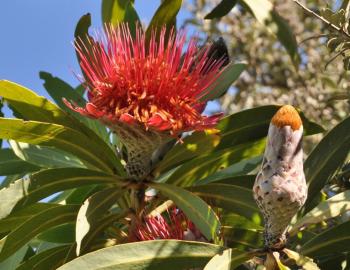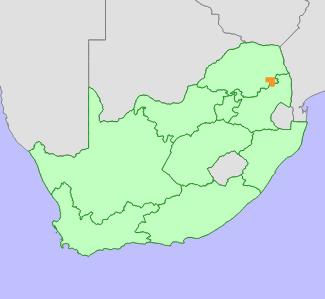Protea laetans
Protea laetans L.E.Davidson
Family: Proteaceae
Common names: Blyde protea, Blyde sugarbush (Eng.); Blydesuikerbos (Afr.)
SA Tree No: 90.4
Introduction
The Blyde protea is a small tree with bluish-green foliage and deep carmine flowerheads, and is one of the few proteas that are found in the summer-rainfall areas of South Africa.

Description
Description
Protea laetans is a slender, upright, sparsely branched tree, 2 to 5 m tall. It has an underground rootstock, and can have a single trunk or up to 6 stems at ground level. Bark is grey, blackening and becoming rectangularly fissured with age.

The leaves are long and narrow, occasionally sickle-shaped, 100-200 mm long and 15-35 mm wide, leathery, hairless, glaucous (covered with a blue-grey bloom), with a yellow margin and tapering to the base. The leaves are clustered at the ends of the branches on the current and previous years' growth, and the lower branches are devoid of leaves.

Flowerheads are showy deep carmine. Before they open, the flowerheads show the silvery, hairy outer surface of the involucral bracts, and the tawny brown tips of the flowers stick out at the tip. The flowerheads open into a shallow, saucer-like bowl and reveal the brilliant carmine inner surfaces of the involucral bracts. The flowerheads are cup-shaped, up to 100 mm in diameter and 10-25 mm long. Each flower is also carmine but the tip of the perianth is covered with tawny brown silky hairs. When in bud, the flowers form a golden-brown hairy mass at the centre of the flowerhead. Flowers are produced during autumn-winter-spring (March to September), but mainly during autumn (April and May).

Conservation Status
Status
Vulnerable (Raimondo et al. 2009). This species occurs over a small area (101 km² ) and consists of five to nine subpopulations of several thousand plants, with scattered plants in the southern part of its distribution range. Its population is declining because it is losing its habitat to holiday resorts which are being developed in the area. It is also threatened by too infrequent fires. This is another factor of the resort development, where the natural fire cycle is not maintained by the resort management, so plants become too old and lose vigour, and they can be smothered by other plants, all of which reduces the number of new seedlings. Plants are also cut down and used for firewood.

Distribution and habitat
Distribution description
Protea laetans is found on the Drakensberg Escarpment in Mpumalanga, from Mogologolo to Bourke's Luck. They grow on quartzitic soils, between 1 000 and 1 400 m elevation, and are largely confined to Northern Escarpment Quartzite Sourveld. They are found in grassland and open bushveld and form a low sparse woodland with a grass understory, or grow in association with Faurea galpinii (Forest Beechwood) and Englerophytum magalismontanum (Transvaal Milkplum) on rocky slopes.

Derivation of name and historical aspects
History
The genus Protea was named in 1735 by Linnaeus after the Greek god Proteus who could change his form at will, because the proteas are so different in form. This species is named after the area in which it is found growing wild, the Blyde River Canyon; both blyde (Afrikaans - pronounced blay-duh ) and laetans (Latin) mean rejoicing or joyous. The Blyde River (River of Rejoicing) was so named in 1844 by a group of Voortrekkers when they were reunited with their leader, Hendrik Potgieter, on the banks of the river. Potgieter had left with a smaller group to trade with the Portuguese at Delagoa Bay (now Maputo), and had failed to return, long after the date set for his return. His party had given him up for lost and they were on their way back to the Highveld when he returned.
Protea laetans was only discovered in 1970 and named in 1975. It was found by Mrs. L.E. Davidson, of the Moss Herbarium at the University of the Witwatersrand. She spotted a group of them growing near the Blyde River holiday resort, recognised it as a new species, and named it after the Blyde River beside which it was found. It could also be said that the name reflects her own joy at its discovery. This species has been in cultivation at Kirstenbosch since 1975.
Protea laetans was at one time thought to be a subspecies of Protea gaguedi, the African sugarbush, but current thinking recognises them as separate species; the two occur together without hybridising, and P.gaguedi has densely hairy young stems and silvery white flowerheads compared with the hairless stems and crimson flowerheads of P. laetans.
The genus Protea consists of about 115 species and occurs in southern and tropical Africa. There are 89 southern African Protea species listed on Plants of southern Africa online (including subspecies). Most proteas, 73 species, are found in fynbos in the Western and Eastern Cape. Only 16 of the southern African species occur outside of fynbos in the summer-rainfall Mpumalanga, Limpopo, Gauteng, Free State, KwaZulu-Natal and North West provinces and in Lesotho and Swaziland.
Ecology
Ecology
Like its relatives in the fynbos, Protea laetans is able to survive fast-moving fires, in this case, grass fires. The plants are able to resprout from their underground rootstock, and from buds under the bark at the base of the old stems. Fire has a rejuvenating effect on these proteas, bringing new, disease-free growth on the old plants that survive, and many new seedlings with the next rains. In the garden, fire can be mimicked, and an older plant rejuvenated by heavy pruning.
Protea laetans flowerheads have a faint nutty odour and are visited by beetles, birds, bees, wasps and mites, but it is not certain which one is the pollinator. Evidence from other summer-rainfall and grassland proteas shows that as a group they are shifting their pollination system from birds to scarab beetles (Tony Rebelo, pers. comm.). The fynbos proteas are mostly bird-pollinated.
Protea laetans seeds are released 9-12 months after flowering. They are dispersed by wind.
Uses
Use
Protea laetans is not used in traditional medicine, or as a commercial cutflower, but wild plants are cut down and used for firewood - a practice that is damaging wild populations and threatening the survival of this species.
Growing Protea laetans
Grow
Protea laetans is not well known in cultivation and is seldom propagated at Kirstenbosch. Although it comes from Mpumalanga, it is not suited to hot, humid conditions typical of the Lowveld. It comes from the cooler, mountainous regions, and, like its Cape relatives, it needs a sunny spot in well-drained (sandy), acidic soils, free air circulation and low humidity, prefers low nutrient fertilisers (such as well-rotted compost) and its roots should be left undisturbed as far as possible.
Protea laetans would look good planted in a small grove or woodland in larger gardens, or used as a large shrub to small tree, or as a backdrop planting, or informal hedge or screen. It is an option for people in summer-rainfall areas that struggle to grow Cape proteas. It has adapted well to the winter-rainfall climate at Kirstenbosch, where the plants do not need additional summer watering.
Protea laetans is relatively slow-growing in cultivation, and flowers may be seen in the second or third season, but plants may take up to 10 years to flower for the first time. They are also long-lived: many of the original plants at Kirstenbosch, nearly 40 years old, are still going strong.
Protea laetans can be propagated by seed or cuttings. Sow seed in spring to early summer. Germination can be erratic, taking 25 to 60 days, and seedlings are very slow-growing. Take semihardwood cuttings from the current season's growth and place in a well-ventilated propagation unit with intermittent mist and bottom-heated benches.
References
- Goldblatt, P. & Manning, J. 2000. Cape plants. A conspectus of the Cape Flora of South Africa. Strelitzia 9. National Botanical Institute, Pretoria & Missouri Botanical Garden Press, Missouri.
- Raimondo, D., Von Staden, L., Victor, J.E., Helme, N.A., Turner, R.C., Kamundi, D.A. & Manyama, P.A. (eds) 2009. Red List of South African plants 2009. Strelitzia 25. South African National Biodiversity Institute, Pretoria.
- Rebelo, Tony. 2001. Proteas. A field guide to the proteas of Southern Africa, edn 2. Fernwood Press, Cape Town.
- Rourke, J.P. 1982. The Proteas of Southern Africa. Centaur Publishers, Johannesburg.
- Schmidt, E., Lotter. M. & McCleland. W., 2002. Trees and shrubs of Mpumalanga and Kruger National Park. Jacana, Johannesburg.
- Vogts, Marie. 1982. South Africa's Proteaceae. Know them and grow them. Struik Publishers, Cape Town.
Credits
Alice Notten
Kirstenbosch National Botanical Garden
July 2012
Plant Attributes:
Plant Type: Shrub, Tree
SA Distribution: Mpumalanga
Soil type: Sandy, Loam
Flowering season: Spring, Autumn, Winter
PH: Acid
Flower colour: Brown, Red
Aspect: Full Sun
Gardening skill:
Special Features:
Horticultural zones











Rate this article
Article well written and informative
Rate this plant
Is this an interesting plant?
Login to add your Comment
Back to topNot registered yet? Click here to register.